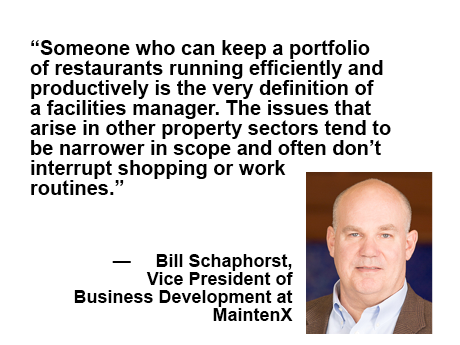When ranking the maintenance and repair challenges associated with everyday commercial real estate spaces — especially those that could just as easily be owned by smaller investors as by institutional capital — putting restaurants at the top of the list is a pretty easy argument to make.
The issues that arise in retail stores or even offices usually aren’t as messy or varied as those that emerge in food-and-beverage operations, points out Bill Schaphorst, vice president of business development at MaintenX, a Tampa, Fla.-based company that provides “curb-to-roof” facility maintenance and repair services for property owners and managers nationwide.
The range of equipment and systems that drive restaurant operations serve myriad functions. What’s more, restaurant components often require low-tech, hands-on solutions: It isn’t unusual for facilities professionals to plunge their hands into some gunk to maintain or repair equipment.
“I’ve always said that someone who can keep a portfolio of restaurants running efficiently and productively is the very definition of a facilities manager,” Schaphorst declares. “The issues that arise in other property sectors tend to be narrower in scope and often don’t interrupt shopping or work routines. Those that occur in restaurants may cause customers to lose their appetite, or worse, affect their health.”
Diverse Environment
The maintenance and repair difficulties that restaurant owners face vary in degree depending on the type of food that’s being delivered, preserved, prepared and served — the needs of a limited-offering bistro selling salads differ significantly from a fried chicken or fish restaurant, for example. Still, most food-and-beverage outlets include gas stoves, gas or electric ovens, deep fryers, walk-in freezers, grease traps and commercial-grade refrigerators, exhaust fans and range hoods, to name a few items. They also require dishwashing machines, ice makers, and soft drink (and sometimes beer) lines.
Most of that equipment needs continuous monitoring and cleaning, which itself typically requires significant employee training. But given the duties that some of the equipment performs, small problems as a result of poor training or oversight can quickly spread to other parts of the building and create additional maintenance headaches and expenses. Ignoring the cleaning of exhaust hoods can lead to a buildup of grease, for example, which then can leak out onto the roof, Schaphorst states.
“In turn, that grease will interact with the roof membrane and will destroy it very quickly,” he cautions. “It’s important to make sure that you’re taking care of your exhaust fans and that the filters to capture the airborne grease are working properly, because you do not want grease on the roof.”
Keep It Comfy
Similarly, the heat generated in kitchens can stress a restaurant’s refrigeration capabilities as well as its heating, ventilation and cooling (HVAC) systems. Therefore, it’s important that restaurants keep refrigerator and freezer condensing coils — typically found behind the units — clean of debris and dust particles, which can impede efficiency and shorten the life of the equipment, Schaphorst explains. Likewise, it’s important to conduct regular check-ups on HVAC systems, including filter replacement, to ensure they run like they should.
“Restaurant managers need to make sure that their customers are happy within the dining environment,” he continues. “If it’s summer, they don’t want to eat in a room that’s 80 degrees. On the other hand, cranking the temperature down too far can cause the air conditioner’s evaporators to freeze — then you have no cooling.”
In the winter, he adds, restaurants need to make sure that they are delivering the proper amount of heat and humidity to create a comfortable climate.
Pipes and Lines
Plumbing presents other potential problems given the fact that stubborn clogs can occur quickly from a number of different sources, primarily grease and disposed food. That means restaurants need to ensure that dishwasher and sink strainers designed to catch food particles are regularly cleaned to prevent debris from building up and overflowing into the pipes, notes Schaphorst.
Much smaller plumbing components that directly affect the customer’s experience, such as the soda pop or beer lines, also need to be cleaned. Additionally, ignoring ice machine maintenance can lead to the development of mold and bacteria in the equipment. It is then transferred to the ice, and eventually, to the customer’s taste buds.
A comprehensive checklist of facility maintenance measures, and a reliable partner to implement fixes ahead of an emergency, can make sure that this and a host of other preventable discomforts never bother the customers or the staff.
— By Joe Gose. MaintenX is a content partner of Retail & Restaurant Facility Business. For more articles from and news about MaintenX, click here.
